INDIO, Calif. — The Coachella Valley Music & Arts Festival started 12 years ago, a few generations by pop measurements. It’s enough time for more than one broad set of tastes to harden and be pushed aside.
Critic’s Notebook
At Coachella, Every Note Is Writ Large

This year’s Coachella festival in California drew up to 75,000 fans to see performances by acts including Arcade Fire, the Strokes and Kanye West, above.
More Photos »
By BEN RATLIFF
Published: April 18, 2011
Multimedia
Related
Blog
ArtsBeat
The latest on the arts, coverage of live events, critical reviews, multimedia extravaganzas and much more. Join the discussion.
And during that period, almost inevitably, it has become a festival about itself. The innovations of this year’s edition, which started Friday at noon and ended in the wee hours of Monday morning, had less to do with programming and more to do with infrastructure — better fences, wider roads approaching the site, more space on the grounds of the enormous Empire Polo Club — and with light-and-sound spectacles.
Many of the acts had played Coachella at least once in previous years, including Kanye West, Kings of Leon, Arcade Fire, New Pornographers, Interpol and the Black Keys. There were no startling reunion sets or challenges to the tone of the festival, which runs from media-approved indie bands in their second or third year (Best Coast, Sleigh Bells) to a slate of trance and dubstep D.J.’s (Paul van Dyk, playing for thousands, or Roska, playing for about 60) to million-sellers wanting to use the festival’s well-branded megaphone.
When performers acted out ambivalence — Julian Casablancas of the Strokes, murmuring jadedly, or Erykah Badu, imperiously teasing the audience with false endings — the pose assumed a little more weight: they were doing this at Coachella, where certain performances now become career markers, watched by up to 75,000 on the field, and, this year, live-streamed around the world on YouTube.
Kanye West, closing the festival on Sunday, made a point of informing the audience that this was the most important show he’d played since his mother died in 2007. (He’s performed at Madison Square Garden a few times since then.) Tyler, the Creator, from the hip-hop collective Odd Future, stalking the grounds, hopping fences, getting expelled and readmitted and generally building a Twitter-trackable subplot of his comings and goings, looked ready to hyperventilate when Pharrell Williams joined his group onstage for a couple of minutes on Friday.
“This is the greatest moment in my life,” he gasped.
The audiovisual happenings made a difference. This year they ran more conceptually, thanks to the Creators Project, a partnership between Intel and Vice, whose work spread across the site’s tents and stages. And so 2,000 giant white balls spilled from the top of Arcade Fire’s stage on Saturday night, each containing an LED light flashing in alternating colors and coordinated with the music. (The band played hard, and the finale offset its vast, rigid and grandiose sound.)
Animal Collective, bumped up in the Coachella hierarchy since its second-stage show five years ago, played its willfully strange drones, surges and yelps against swirly video backdrops created for the occasion by the band Black Dice. They were positioned under giant hanging cubes, and inside one, too: the main-stage doors slid open and shut this year, with lights running along their gridlines.
A collaboration between J. Spaceman of the band Spiritualized and the film director Jonathan Glazer turned out to be a three-day installation piece, a long, dark tent punctuated by five rectangular shafts of light. As you wandered through, you heard the Spiritualized track “Ladies and Gentleman, We Are Floating in Space”— a bleary hymn based on Pachelbel’s Canon — looping in surround-sound. When you lay in the bright rectangles, you felt the heat of strong lamplight reflected off mirrors in the ceiling, and from the directional speakers you suddenly heard the vocals, as if you were putting your ear to a whispering wall. It was an intimate experience in a storm of dipsy-doodle.
There were, in fact, some reunion shows, but more nostalgic than fire-starting. From the ’80s: the London group Big Audio Dynamite, led by Mick Jones, once of the Clash, and by Caifanes, from Mexico City, playing glossy, proggy new-wave. From the ’90s, the Britpop guitar band London Suede. And on Sunday, from the oughts — they only broke up five years ago!— came Death From Above 1979, the noisy, dancey bass-drums duo. (An hour later on the same day, another duo — Lightning Bolt, longer-running and never broken up — delivered a wilder and better version of the bass-and-drums idea.)
Singers with a Y had it: not just Erykah Badu, but also Ms. Lauryn Hill, hoarse but tenacious, driving her band; Robyn, the Swedish high-voiced pixie aerobicist, lodging sublime integrity in nearly weightless music; and Yelle, making sunny French electro-pop with clean lines and ice-cream hooks. And some of the outliers — angrier artists in a generally smiley lineup or genuine mixed-messagers amid the party-time bands — made themselves memorable.
- 1
- 2













